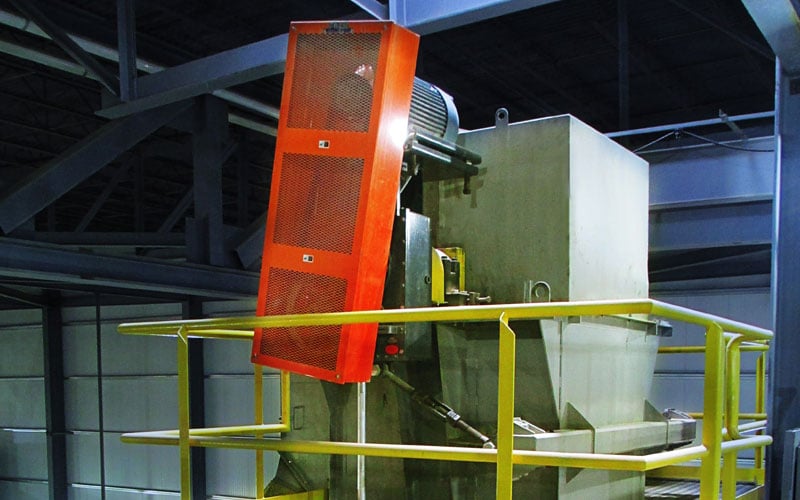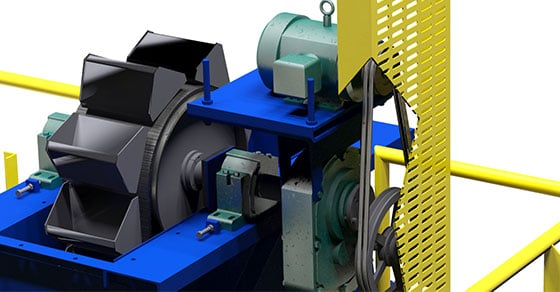The drive assembly is a critical consideration in the design of a bucket elevator, with the potential to impact both productivity and equipment service life. The following covers the different configurations, their advantages in different settings, and optional modifications.
Drive Assembly Options for Bucket Elevators
Historically, bucket elevator manufacturers utilized a foot-mounted motor that was direct coupled to an in-line reducer. The reducer would then be connected to the elevator head shaft with a low-speed chain. While some older elevators may still use this drive type, it has become obsolete over time as technology has advanced.
Today, bucket elevator manufacturers employ one of several variations on the shaft-mounted reducer design. This eliminates the use of a low-speed chain, which is not only costly, but requires regular lubrication.
Shaft-Mounted Reducer with Top-Mounted Motor
For lower-capacity operations (typically those running at 50 HP or less), the shaft-mounted reducer with top-mounted motor offers a cost-effective option. The motor and reducer are connected by high-speed V belts, which are most commonly used in low-capacity settings.

Bucket Elevator with top-mounted motor and shaft-mounted reducer connected by high-speed V belts (under guard)
In settings over 50 HP, high-speed V belts are typically not suitable, as they are unable to provide the power transmission capabilities necessary, making the upgrade to direct coupling of the motor and reducer a requirement.
Shaft-Mounted Reducer with Right-Angle Drive
When space is limited, manufacturers can utilize a right-angle drive setup in which the motor (input shaft) and reducer (output shaft) are direct coupled at a right angle. This eliminates the high-speed V belts, as well as overhang of the motor, significantly reducing the drive assembly footprint.
The required upgrade from high-speed V belts to direct coupling of the motor and reducer is also advantageous in settings where high-speed V belts would be undesirable, such as when equipment is operating in a dusty environment, or outdoors, which could interfere with belt operation.
Direct Coupling Options
The motor and reducer can be direct coupled using either couplings or a C-face motor input.
Couplings
When it comes to couplings, manufacturers can connect the motor and reducer with either a traditional high-speed coupling, or a high-speed fluid coupling.
The upgrade to a high-speed fluid coupling, while more costly, significantly reduces wear on the reducer, as well as sprockets and chains, reducer gears, etc., because it prevents shock loading. This option is ideal for high-horsepower settings or when frequent starts/stops will be required.
In the case of a traditional coupling, a variable frequency drive (VFD) can be incorporated to program a soft start and reduce shock loading on the drive components.
C-Face or Flange Motor Input
Direct drives can also be fitted with a “C-face” motor input (also known as a flange motor input) as an alternative to a coupling, allowing for much easier removal of the motor from the reducer.
While a properly maintained reducer has an extensive service life, when the time comes to replace it, or the head shaft, the C-face motor input makes the swap substantially faster; instead of dismantling the entire coupling, maintenance personnel need only undo a few bolts.
Additional Drive Options
Creep Drive or Local VFD
An auxiliary creep drive can be incorporated into the unit to allow for easier maintenance, reducing unit speed by a factor of ten. This is ideal when operators need to replace specific buckets, or observe the unit at a reduced speed.
Creep drives can only be implemented on larger units and are not compatible with high-speed V belts. An alternative gaining popularity to creep drives is the use of a local VFD.
A local VFD can offer the same capabilities as the creep drive, but at a fraction of the cost. And unlike creep drives, VFDs can be incorporated into any size bucket elevator. They can also be locked out so they are only accessible to specific users.
Swing Base
The motor, reducer, and coupling can be neatly mounted together on one common base through the use of a swing base. Because all components are contained on a single support frame, it is easier to maintain perfect alignment between the motor and reducer.
Output Shaft Coupling
The low-speed output shaft from the reducer can be connected to the elevator with either a rigid coupling or hollow bore, a type of shrink-fit connector. While the rigid coupling is more costly and occupies a larger space, it makes removal of the reducer significantly more easy.
Instrumentation
Drive assemblies can also be fitted with an array of instrumentation technologies to automate operation and give operators more tools for optimizing performance and maintenance procedures.
Various sensors can be installed to monitor aspects of elevator health, such as:
- Oil level
- Oil quality
- Motor and oil temperature
- Vibration
These sensors, incorporated into the programmable logic controller (PLC) can allow operators to monitor system operation and even alert operators when a parameter falls out of its designated specification, giving them the opportunity to intervene before a serious issue occurs.
Conclusion
Configuring a drive assembly to meet its expected duty is an essential aspect of plant productivity and equipment service life. With several options available, producers should work with a qualified original equipment manufacturer (OEM) to establish the best design for a given application.
FEECO has been a leader in manufacturing custom bucket elevators for vertical conveying of bulk solids since 1951. All FEECO elevators are engineered for reliability and longevity, with extensive support available from our parts and service team. For more information on our bucket elevators, contact us today!



